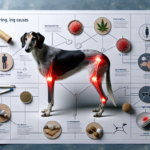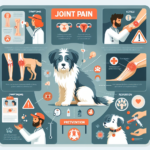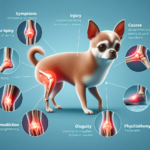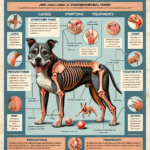Deerhound Joint Pain: Causes, Symptoms, Prevention, and Treatment

Introduction
Deerhounds, also known as Scottish Deerhounds, are a majestic and ancient breed with a rich history dating back to the Middle Ages. Originally bred for hunting deer in the Scottish Highlands, these dogs are known for their grace, speed, and gentle temperament. Deerhounds are characterized by their tall, lean bodies, wiry coats, and long, narrow heads. Despite their large size, they are known for their calm and friendly nature, making them excellent companions.
Like many large breeds, Deerhounds are prone to certain health issues, with joint pain being a significant concern. Joint health is crucial for Deerhounds due to their active lifestyle and the physical demands placed on their bodies. Understanding the causes, symptoms, prevention, and treatment of joint pain in Deerhounds is essential for ensuring their well-being and quality of life.
Breed-Specific Joint Pain Risks
Genetic Predisposition
Deerhounds have a genetic predisposition to several joint-related issues, including hip dysplasia, arthritis, and elbow dysplasia. Hip dysplasia is a condition where the hip joint does not fit properly into the hip socket, leading to pain and mobility issues. Arthritis, a degenerative joint disease, is also common in Deerhounds, causing inflammation and pain in the joints. Elbow dysplasia, a developmental disorder of the elbow joint, can lead to chronic pain and lameness.
Age-Related Risks
As Deerhounds age, the risk of developing joint pain increases. The breed typically reaches senior status around 6-8 years of age, and it is during this time that joint issues may become more apparent. Owners should be vigilant in monitoring their Deerhounds for signs of joint pain as they age, as early detection and intervention can significantly improve the dog’s quality of life.
Activity Level and Joint Stress
Deerhounds are known for their high activity levels and love for running and chasing. While regular exercise is essential for their overall health, excessive or high-impact activities can put stress on their joints, leading to pain and injury. Owners should balance their Deerhound’s need for exercise with activities that are gentle on the joints to prevent long-term damage.
Common Symptoms of Joint Pain in Deerhounds
General Symptoms
- Limping or favoring one leg
- Stiffness, especially after rest or exercise
- Reluctance to move, jump, or climb stairs
- Decreased activity or interest in play
- Swelling or heat around the joints
- Whining or showing signs of discomfort when touched
Breed-Specific Symptoms
In Deerhounds, joint pain may manifest as a noticeable change in their gait, with a tendency to “bunny hop” when running or walking. They may also show a reluctance to engage in activities they previously enjoyed, such as running or playing fetch. Due to their size, any changes in movement or behavior should be taken seriously and evaluated by a veterinarian.
When to Consult a Vet
If a Deerhound exhibits any of the symptoms listed above, it is essential to consult a veterinarian promptly. Early diagnosis and treatment can prevent further joint damage and improve the dog’s quality of life. Regular veterinary check-ups are also crucial for monitoring joint health and catching any issues early.
Preventive Measures for Joint Health
Exercise Recommendations
To maintain joint health in Deerhounds, it is important to provide regular, low-impact exercise. Activities such as walking, swimming, and gentle play are ideal for keeping their joints healthy without causing excessive stress. Avoid high-impact activities like jumping or running on hard surfaces, as these can exacerbate joint issues.
Dietary Suggestions
A balanced diet rich in essential nutrients is vital for supporting joint health in Deerhounds. Foods containing glucosamine, chondroitin, and omega-3 fatty acids can help maintain joint function and reduce inflammation. Supplements specifically designed for joint health can also be beneficial, but it is important to consult a veterinarian before adding any new supplements to the dog’s diet.
Weight Management
Maintaining a healthy weight is crucial for reducing joint stress in Deerhounds. Excess weight can put additional pressure on the joints, leading to pain and degeneration. Owners should monitor their Deerhound’s weight and adjust their diet and exercise routine as needed to keep them at an optimal weight.
Early Screening and Monitoring
Regular veterinary check-ups and early screening for joint issues are essential for catching problems early. X-rays and other diagnostic tests can help identify joint abnormalities before they become severe. Monitoring the dog’s movement and behavior can also provide early clues to potential joint issues.
Treatment Options for Joint Pain
Non-Surgical Treatments
Non-surgical treatments for joint pain in Deerhounds include medications, physical therapy, and lifestyle adjustments. Anti-inflammatory medications and pain relievers can help manage pain and reduce inflammation. Physical therapy, including exercises and massage, can improve joint function and mobility. Lifestyle adjustments, such as providing a comfortable bed and avoiding high-impact activities, can also help alleviate joint pain.
Surgical Options
In severe cases of joint pain, surgical intervention may be necessary. Common surgical options for Deerhounds include hip replacement, arthroscopy, and joint fusion. These surgeries can provide significant relief from pain and improve mobility, but they also come with risks and require a thorough evaluation by a veterinarian.
Alternative Therapies
Alternative therapies such as acupuncture, hydrotherapy, and massage can also benefit Deerhounds with joint pain. Acupuncture can help reduce pain and inflammation, while hydrotherapy provides low-impact exercise that is gentle on the joints. Massage can improve circulation and reduce muscle tension, providing relief from joint pain.
Lifestyle and Management Tips
Daily Care Routine
A daily care routine for managing joint pain in Deerhounds should include regular, low-impact exercise, a balanced diet, and any prescribed medications or supplements. Gentle stretching exercises and massage can also be incorporated into the routine to improve joint function and reduce pain.
Modifying the Home Environment
Making the home environment more comfortable for a Deerhound with joint pain can significantly improve their quality of life. Providing ramps or steps to help them access furniture or climb stairs can reduce joint stress. Orthopedic beds can provide additional support and comfort for their joints. Ensuring that food and water bowls are at an appropriate height can also help reduce strain on their joints.
Long-Term Management
Long-term management of joint pain in Deerhounds involves regular veterinary check-ups, ongoing monitoring of their condition, and making necessary adjustments to their care routine. Keeping the dog active and engaged with gentle exercises and activities can help maintain their mobility and overall well-being. Owners should also be prepared to make lifestyle changes as needed to accommodate their dog’s changing needs.
FAQs About Deerhounds and Joint Pain
What are the early signs of joint pain in Deerhounds?
Early signs of joint pain in Deerhounds include limping, stiffness, reluctance to move, and changes in behavior or activity levels. If you notice any of these signs, it is important to consult a veterinarian for a thorough evaluation.
Can joint pain in Deerhounds be prevented?
While it may not be possible to completely prevent joint pain in Deerhounds, taking preventive measures such as providing regular, low-impact exercise, maintaining a healthy weight, and offering a balanced diet with joint-supporting nutrients can help reduce the risk and severity of joint issues.
Are there specific exercises that are better for Deerhounds with joint pain?
Yes, low-impact exercises such as walking, swimming, and gentle play are ideal for Deerhounds with joint pain. These activities help maintain joint function and mobility without causing excessive stress on the joints.
What dietary supplements can help support joint health in Deerhounds?
Supplements containing glucosamine, chondroitin, and omega-3 fatty acids can support joint health in Deerhounds. However, it is important to consult a veterinarian before adding any new supplements to your dog’s diet.
When should I consider surgical options for my Deerhound’s joint pain?
Surgical options should be considered when non-surgical treatments are no longer effective in managing your Deerhound’s joint pain, and the pain significantly impacts their quality of life. A thorough evaluation by a veterinarian is necessary to determine the best course of action.
Conclusion
Joint pain is a common concern for Deerhounds, but with proper care and attention, it is possible to manage and alleviate their discomfort. By understanding the causes, symptoms, prevention, and treatment options for joint pain, owners can take proactive steps to ensure their Deerhound’s joint health and overall well-being. Regular veterinary check-ups, a balanced diet, appropriate exercise, and a supportive home environment are key components in maintaining a happy and healthy Deerhound. Remember, early detection and intervention are crucial, so always consult your veterinarian if you notice any signs of joint pain in your Deerhound.




